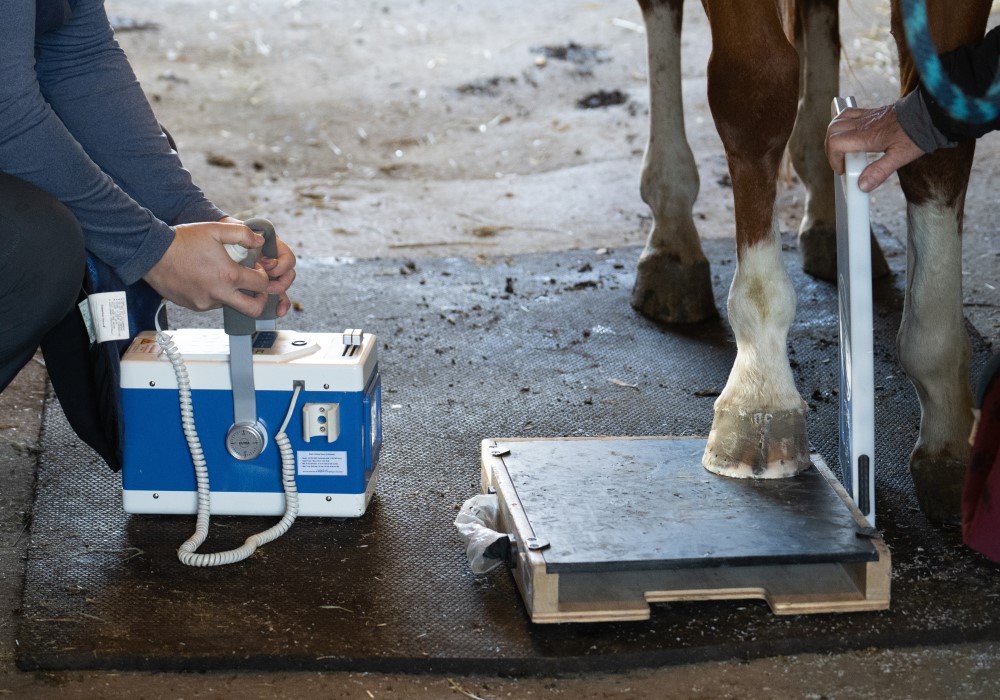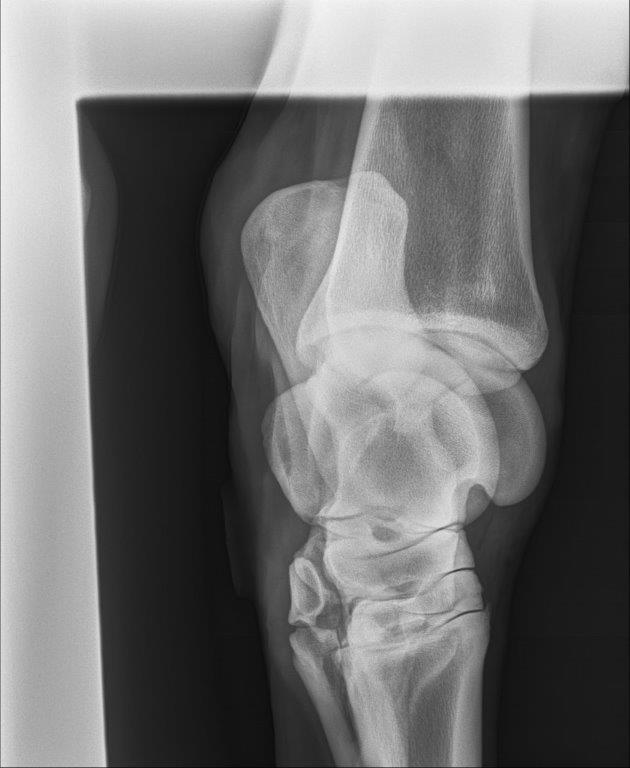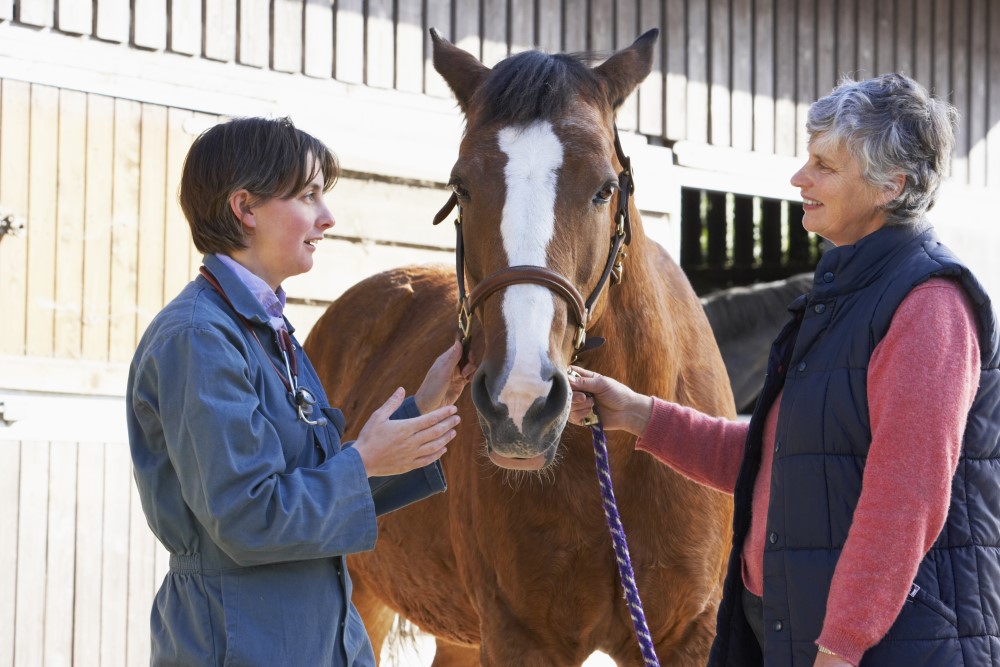Prepurchase examinations (PPE) are commonly used by prospective buyers to gain a better insight into the health and wellbeing of the horse they want to purchase. A PPE can be performed in a variety of ways and differs between cases depending on the veterinarian, the horse, and the buyer’s requirements.
When it comes to supplementary diagnostic tests, there is a myriad of additional information that can be obtained when they are used – however, it is up to the prospective purchaser to decide how much additional information they require before purchasing a horse. Radiography (X-rays) is one example of a supplementary diagnostic tool that is commonly requested with a PPE, and in this article we shall discuss the pros and cons of incorporating X-rays into a PPE.

X-rays allow the veterinarian to have a better knowledge of the bone structure of the areas that are X-rayed. They do not give the vet the ability to predict the future, but rather allow them to calculate a more informed risk assessment. Sometimes there are lesions detected on an X-ray that give the vet a strong indication that the horse will be unsuitable for the purpose the prospective buyer requires.
Often, the vet would have been suspicious that such a lesion was possible because they identified abnormalities or symptoms on a thorough clinical examination. Where it becomes more difficult is when a lesion is detected that is currently not affecting the horse or its performance, so assessing these anomalies requires good communication between the vet and the purchaser.
WHERE TO START
1. The first question to be decided once radiographs have been requested is what areas or joints should be X-rayed. Sometimes a potential purchaser will have seen something on the horse, such as a swollen joint, and ask specifically for that site to be X-rayed. Other times, the potential purchaser will ask to be contacted after the clinical examination and then request certain joints or sites be X-rayed based on the veterinary recommendations. In these cases, the vet has concerns with certain areas and suggests that X-rays be performed to look for any radiographical evidence that may correlate with the clinical exam. For instance, a swollen or painful fetlock joint might have radiographic evidence of degenerative joint disease, suggesting the horse could have ongoing issues after purchase. Contrary to this is the painful fetlock that may show no evidence of any radiographic change in which case, the vet and prospective purchaser need to discuss the possible future outcomes should the sale proceed.
Often, however, the purchaser would like a “set of standard X-rays” just to be sure there isn’t one or more problems. This is where good communication between the veterinarian and the purchaser, before the examination takes place, is paramount to ascertain what is a “standard set of X-rays”.

The number and site of many recommended X-rays is dependent on what discipline the horse is being purchased for. For yearling racehorses in Australia, this has been determined to include front feet, all four fetlocks, knees, hocks, and stifles. Racehorses going to Hong Kong require additional views of the listed joints to be performed. For dressage horses, the inclusion of neck and back X-rays are becoming more common due to the acknowledgement that spinal arthropathies can affect the fluent movement of a horse. Many countries within Europe vary in the number of views they take of certain joints but tend to include laterals of the hind feet and don’t include X-rays of the knees.
“Back X-rays are very
limited in what information
they can provide…”
Many people use X-rays of the dorsal spinous process of the vertebrae along the back to look for possible kissing spines or spinous processes that impinge on one another. It should be noted, however, that back X-rays are very limited in what information they can provide. This is because most portable X-ray machines do not have the ability to penetrate deep enough along the back and adequately expose the vertebral bodies of the spine meaning any information gained, aside from the upper areas of the spinous processes, is limited.
The decision of what anatomic sites to X-ray, and in turn what views of those sites should be taken, is dictated by several key factors including breed, age, previous history, and future intentions. For instance, assessing a breeding Warmblood for potential OCD lesions will often mean X-raying hocks, stifles and all four fetlocks, whereas a racing Thoroughbred is more likely to need its knee and front fetlocks X-rayed to assess these structures for degenerative joint disease. A vet will usually suggest an aged pony is a good candidate to have their feet X-rayed, due to the common occurrence of laminitis that can be associated with some metabolically challenged breeds.

“Horses that have competed
for many years commonly
have minor changes on X-rays.”
DISCUSS THE COSTS
2. Discussing with the veterinarian the cost of routine X-rays is also important. Theoretically, cost should not be important when we want the best assessment we can have, but in practice, a commonsense approach is very important. X-rays can become very expensive when randomly selecting multiple sites without good reasoning. It is not uncommon to incur a fee more than $1000 to X-ray multiple joints. This might be acceptable if the horse being purchased is expensive, or if there will be a lot of time and money involved in transporting or training the horse once purchased. But spending $1500 for X-rays on a horse that is selling for $2000 and is being purchased for the occasional trail ride is not necessarily money well spent. Whereas spending $200,000 on a horse probably warrants survey X-rays on the major joints – but this is for the prospective buyer to decide, as sometimes they are happy to purchase a horse based solely on the clinical examination.
3. Interpretation of the X-ray findings is equally as important as acquiring good quality X-rays. It is important that X-ray changes are interpreted in relation to the horse’s age and its intended purpose. An OCD lesion in a 12-year-old horse is much less significant than the same lesion in a yearling. OCD lesions usually develop in young horses (<2yo), therefore, a 12-year-old horse that has worked with an OCD lesion for 10 years without any clinical problems developing, is unlikely to have these lesions cause a clinical issue in the future. A yearling, however, that is diagnosed with an OCD lesion, may develop lameness once it starts to train so, needs to be assessed differently.
Horses that have competed for many years commonly have minor changes on X-rays, frequently referred to as “wear and tear”, and these need to be assessed with realistic expectations as it extremely unlikely that a well-seasoned horse is going to have perfect joints. A veterinarian’s interpretation of an X-ray will be influenced by his or her experience with horses used for similar equine disciplines, and not all veterinarians will share the same opinion.
4. An owner’s previous experience with horses and any associated X-ray changes will also influence what areas of the horse they would like X-rayed, irrespective of what the veterinarian may suggest. If an owner has had a horse with a large elbow cyst that rendered a previous horse unsuitable to ride, they may feel more comfortable doing elbow X-rays for their peace of mind, even though the veterinarian feels it is unnecessary. This is where the vet needs to listen to the concerns of the purchaser and abide by their wishes (good communication!).
5. Not all X-ray findings are black and white, and this can cause some concern to a prospective purchaser. In these cases, there are several options available to the veterinarian and the purchaser. For lower (distal) parts of the limbs, CT scans can be utilised to thoroughly assess the bone quality and provide better evidence on whether a radiographic bony anomaly is significant or not. This usually requires a horse being transported to a larger equine facility to obtain the images; however, if the horse is an expensive purchase, a CT study can make a decision regarding future performance much clearer.
A SECOND OPINION
Sometimes sourcing a second opinion from a specialist may provide additional information that enables the veterinarian and purchaser to have a better understanding of potential pathologies that might develop. This can be useful, especially with neck X-rays due to the complexity in assessing the vertebrae with their multiple overlapping joints and only requires X-rays to be forwarded over the internet and assessed for a fee.
Other options to compliment a radiographic assessment include MRI and scintigraphy; however, such diagnostic examinations would usually be limited to very expensive horses.

6. Feasibility to X-ray a horse must also be taken into consideration when requesting radiographs on a PPE. Some horses are tolerant of having X-rays taken, especially of the lower fore limbs, but others can require sedation to place the X-ray plate close to the joint, especially in areas like the stifle. Permission from the vendor to sedate a horse is required before any medication is administered and this may not be given if the horse is close to a competition and there are concerns on drug withdrawal times. If this is the case, then the X-rays may need to be performed later once the horse has competed. Other times, even sedated horses will not tolerate having multiple X-rays taken as can happen with unbroken horses. When this occurs, the veterinarian and the purchaser will need to reassess their options and expectations as an injury to a handler or to the horse before it is purchased, can have significant repercussions for all parties.

When purchasing a new horse, good communication between the prospective purchaser, the veterinarian and the vendor is paramount so that all parties are aware of the intended use of the horse and the procedures involved in assessing that horse for sale. The addition of X-rays to a thorough clinical pre-purchase examination can be very fruitful but relies on good communication between the vet and the purchaser, as the value lies in the interpretation of the X-rays and the purchaser’s expectations of the knowledge they are going to acquire with these X-rays. As with all the information provided by the PPE, the X-ray results can help guide the prospective purchaser to make a better-informed decision but can never accurately predict the future or the horse’s longevity. EQ
YOU MIGHT ALSO LIKE TO READ BY DR MAXINE BRAIN:
Bandaging Tendons: Is It All Bad News? – Equestrian Life, April 2024
Diagnosing Respiratory Issues – Equestrian Life, March 2024
Anhidrosis: What Is Is? – Equestrian Life, January/February 2024
Fractured Jaws – Equestrian Life, December 2023
Keeping Our Country Free of Disease – Equestrian Life, November 2023
Managing Endometritis – Equestrian Life, October 2023
Granulosa Cell Tumours – Equestrian Life, September 2023
Being a Horse in Africa – Equestrian Life, August 2023
Splint Bone Fractures – Equestrian Life, July 2023
When Horses Choke – Equestrian Life, June 2023
The Challenge of Treating HPSD – Equestrian Life, May 2023
From the Horse’s Mouth: Salivary Glands – Equestrian Life, February 2023
Cardiac Murmurs – Equestrian Life, February 2023
Matters of the Heart – Equestrian Life, January 2023
Umbilical Concerns in Foals – Equestrian Life, December 2022
Retained Foetal Membranes – Equestrian Life, October 2022
Preparing for Laminitis – Equestrian Life, September 2022
Working Together for Best Outcomes – Equestrian Life, August 2022
What Constitutes an Emergency – Equestrian Life, July 2022
Peri-Tarsal Cellulitis Calls for Quick Action – Equestrian Life, June 2022
Sinusitis: Not To Be Sneezed At – Equestrian Life, May 2022
Japanese Encephalitis: No Cause For Alarm – Equestrian Life, April 2022
Hernia Learning Curve – Equestrian Life, March 2022
Osteochondromas: Benign But Irritating – Equestrian Life, February 2022
Don’t Forget the Water – Equestrian Life, January 2022
Don’t Forget the Water – Equestrian Life, January 2022
Understanding Anaesthesia – Equestrian Life, December 2021
A Quick Guide to Castration – Equestrian Life, November 2021
Caring for Mammary Glands – Equestrian Life, October 2021
Sepsis In Foals – Equestrian Life, September 2021
Understanding Tendon Sheath Inflammation – Equestrian Life, August 2021
The Mystery of Equine Shivers – Equestrian Life, July 2021
Heads up for the Big Chill – Equestrian Life, June 2021
The Ridden Horse Pain Ethogram – Equestrian Life, May 2021
The Benefits of Genetic Testing – Equestrian Life, April 2021
Heavy Metal Toxicities – Equestrian Life, March 2021
Euthanasia, the Toughest Decision – Equestrian Life, February 2021
How to Beat Heat Stress – Equestrian Life, January 2021
Medicinal Cannabis for Horses – Equestrian Life, December 2020
Foal Diarrhoea Part 2: Infectious Diarrhoea – Equestrian Life, November 2020
Foal Diarrhoea (Don’t Panic!) – Equestrian Life, October 2020
Urticaria Calls For Detective Work – Equestrian Life, September 2020
Winter’s Scourge, The Foot Abscess – Equestrian Life, August 2020
Core Strengthening & Balance Exercises – Equestrian Life, July 2020
The Principles of Rehabilitation – Equestrian Life, June 2020
When is Old, Too Old? – Equestrian Life, May 2020

